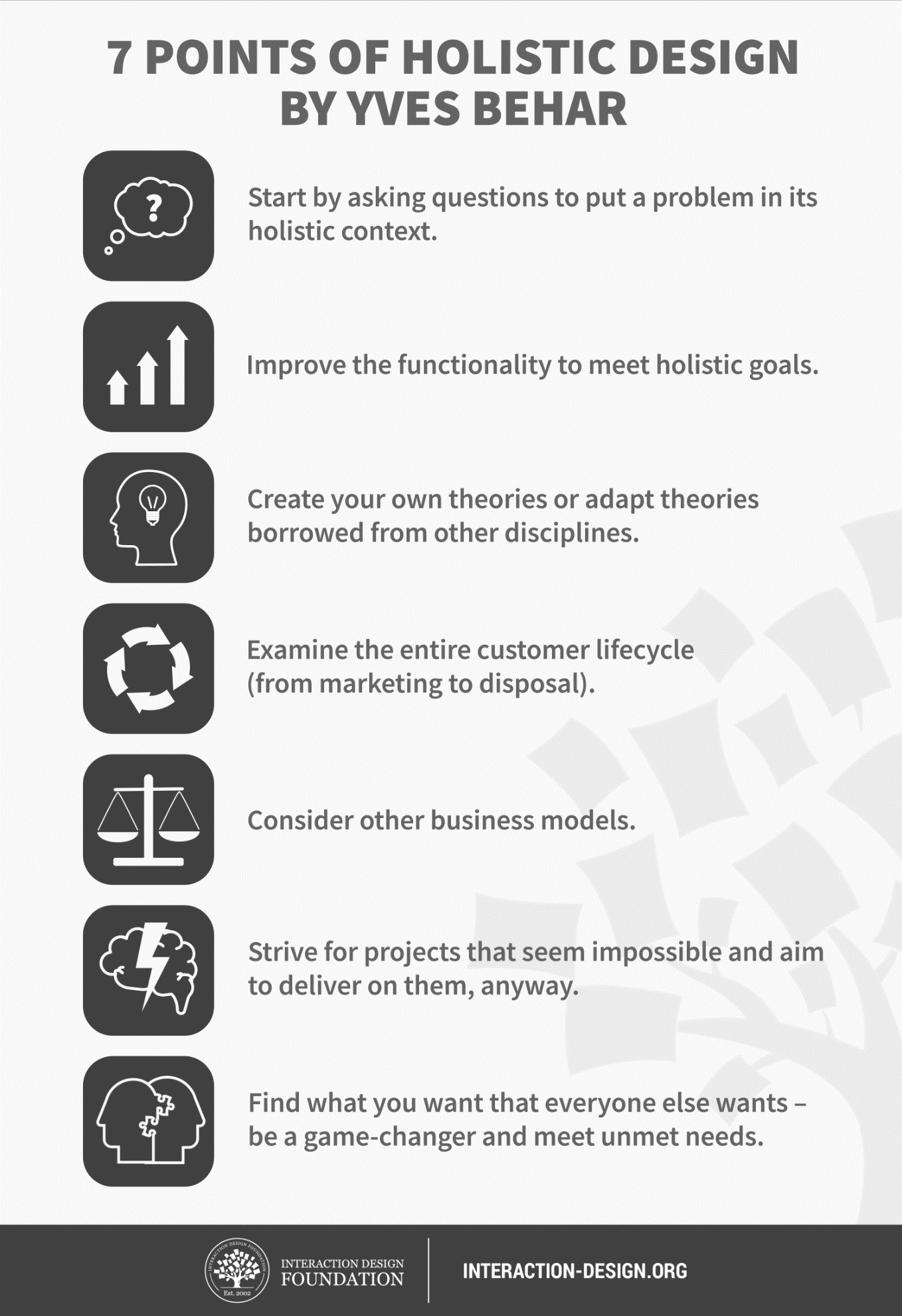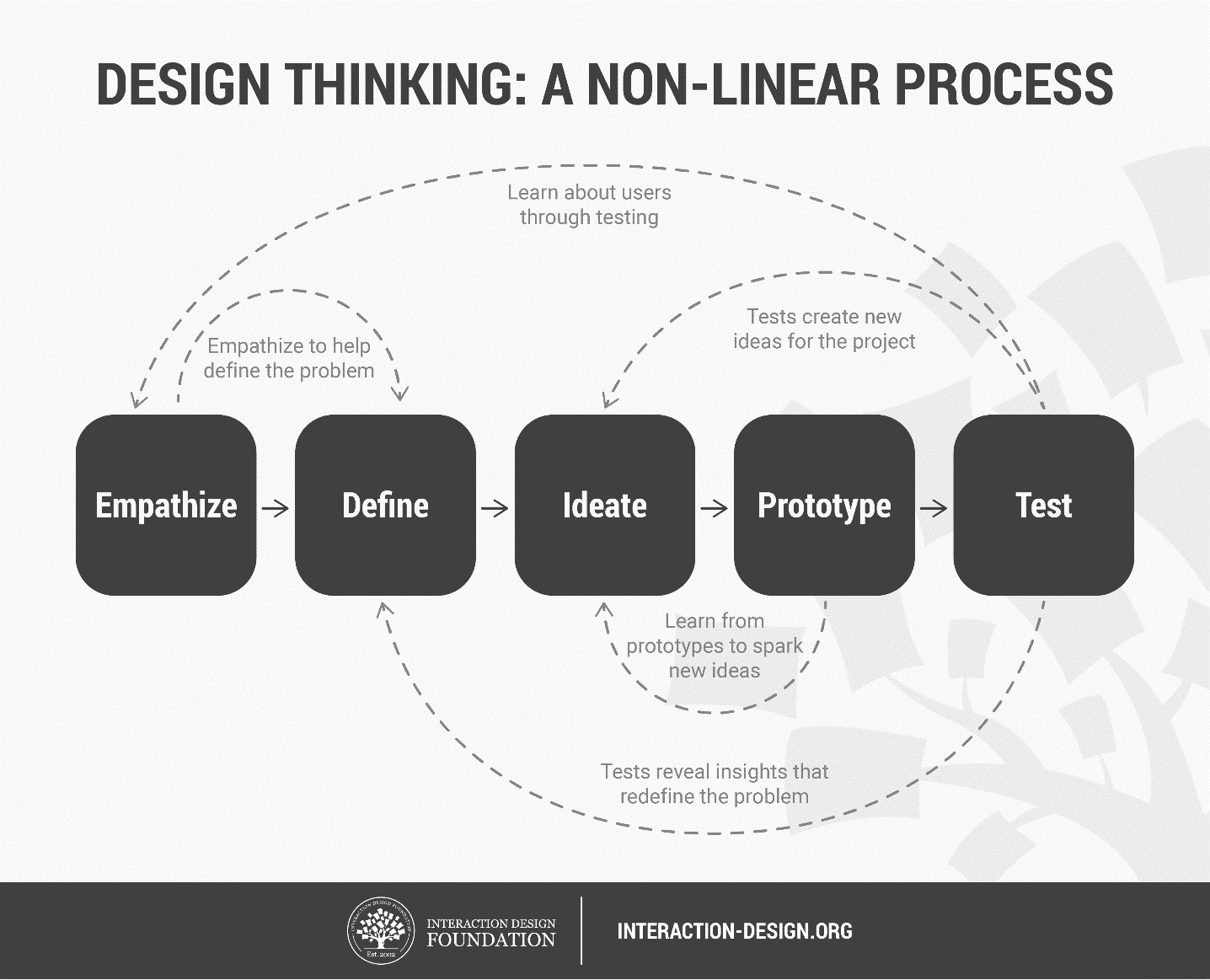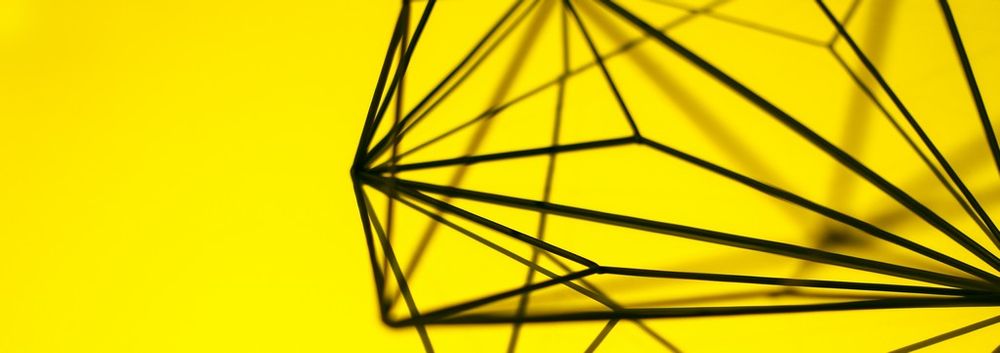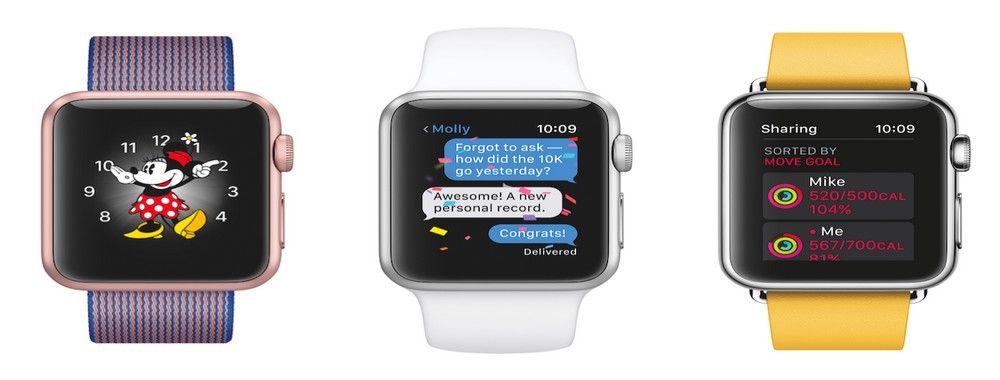Meet the Eames – Function is the Key to Design

- 602 shares
- 10 years ago
When design teams do holistic design in user experience (UX) design, they take a bird’s-eye view of users’ interactions in their world and the many interconnected factors in their contact with brands. Teams picture how a product/service fits—or might fit—into the wider consumer or user world
“Holistic design takes into account the person, the device, the moment, the ethnographic environment, the physical space as well as human behavior and psychology, i.e. thinking, attitudes, emotions, motivations, abilities, triggers etc., and aims to deliver an optimal experience. At times the entire experience (with a product or brand) is not limited to digital devices but is a mix of digital, real-world brick-and-mortar, and human-to-human interactions.”
— Miklos Philips, Principal UX Designer at Toptal
Structural architects developed holistic design as a way to do better than build for just one purpose (e.g., to house people). The idea was to examine views of human occupancy from all angles (e.g., energy consumption, mental health). Therefore, they could design buildings tailored to everything the people who used them needed.
In user experience, designers try to work with a better grasp of all the human dimensions that are involved between users and a particular design. They can explore the various angles more realistically than they would if they focused only on catering to a few aspects of what the users experience (e.g., designers creating an impressive user interface (UI) design but not considering other aspects, such as search engine optimization (SEO)). From there, designers can examine the intricate dynamics in users’ different environments to get a better idea of the balance they need to achieve in their design. Then, they can customize feature sets from the insights they discover. With a holistic mindset, your team doesn’t examine isolated aspects of how users use products/services and experience brands. Instead, you consider how these aspects work together. Therefore, you can predict the series of micro-moments users have across all touchpoints during their experience. Industrial designer Yves Behar captured holistic design in seven points, condensed as follows:

To adopt a holistic design approach, organizations may need to change their cultural mindset. Here are the main holistic considerations:
Because one interaction is typically only part of a series auser takes towards a goal, examine where one task fits in overall and make the best entry and exit points (e.g., checkout).
Investigate cause-and-effect chains and get behind users’ eyes with, for example, design thinking. Issues aren’t typically isolated. They can be wicked problems (i.e., extremely intricate). If decision-makers “solve” one problem but fail to consider associated issues, they can cause repercussions.
Design for the transitions between interactions – users access products/services in various circumstances and ways. Twenty-first-century user experiences consist of many user moments where users pursue goals in many ways. Previously, there was one way (e.g., to buy vacations from a bricks-and-mortar travel agent).
Use customer journey maps, user stories, personas and touchpoints matrices to help illustrate the entire user context and the associated systems and tangent issues.
Produce sufficient resources for all touchpoints. For example, the designers of a municipal bicycle system in a city that requires helmets must examine how to supply helmets. Similarly, UX designers must predict both digital and physical aspects of users’ needs.

Design thinking can be a good method to use for holistic design because it helps make sense of the many complex and intertwined human-world realities in which users will access, use and judge designs/products. It can therefore help you address all angles of the user experience—*holistically*.
With holistic design, your aim is to design for a successful UX ecosystem. You should therefore create a branded experience which covers many dimensions of use. You must make designs that offer seamless interactive experiences to facilitate that. A holistic user experience reflects empathy for users. Moreover, it’s proof that a design team has built in the comfort (or delight) users expect in the flow of actions they take after they discover a brand. To achieve this, your team has to tailor every dimension to match the many independent relationships (i.e., users, their behavior and aims, the other technology they use, etc.) that happen across specific touchpoints.
You can learn more about design thinking with our course here.
This piece shows the challenges involved with holistic design.
Smashing Magazine’s examination of holistic design strategies features a touchpoints matrix.
Holistic design in UX (user experience) and product design means crafting experiences that consider the entire user journey across devices, environments, emotions, and touchpoints. Instead of focusing on isolated screens or features, holistic design looks at how everything connects to serve users' goals.
This approach integrates physical and digital interactions, user behaviors, and the broader context in which a product exists. It emphasizes consistency, accessibility, and emotional resonance, and it ensures that every aspect of the design contributes to a seamless and meaningful user experience. For instance, companies like Apple and Spotify employ holistic design to create cohesive ecosystems that enhance user satisfaction and loyalty.
By adopting holistic design, teams can deliver products that don't just meet functional requirements but also resonate with users on a deeper level, fostering trust and long-term engagement.
Explore our article Top Tips to Create Effective Journey Maps and get valuable insights into how to meet your users with products that help them best, when and where they need it.
Holistic design differs from traditional design by focusing on the full user journey, not just individual screens, features, or tasks. Traditional design often isolates problems, tackling one element at a time. Holistic design, on the other hand, considers how all parts of the experience work together across time, channels, and user emotions.
This approach examines the entire ecosystem: product, service, brand, and environment. It ensures that visual design, functionality, and tone align across touchpoints. For example, a holistic design does not just perfect an app interface—it connects it smoothly to customer support, onboarding emails, and in-store experiences.
Companies like Airbnb and Netflix apply holistic design to create seamless, memorable experiences that build brand loyalty. It turns products into systems and moments into journeys.
Explore how to meet users at the levels they expect to find your brand, with customer journey maps.
Holistic design solves key problems in UX and UI (user interface) design by eliminating gaps, inconsistencies, and fragmented experiences. It addresses issues where different parts of a product don't “talk” to each other, like when an app's interface feels disconnected from its customer service or when branding clashes across touchpoints.
By looking at the full user journey, designers and teams who employ holistic design can ensure that every interaction, across devices, channels, and moments, feels seamless, intentional, and emotionally consistent. They can also reduce friction caused by ineffective approaches like short-term design fixes.
For example, banks that apply holistic design streamline their mobile, web, and in-branch experiences, creating trust and ease for users. Holistic design also helps with accessibility by designing systems that support diverse users throughout the entire flow—not just on one screen.
Get a wider view of design in this video, which examines how user experience goes beyond just what users find on a screen:
Holistic design stands on key principles that ensure a seamless, user-centered experience across every touchpoint. The core principles include:
1. Systems thinking: View the product as part of a larger ecosystem. Every element—UI, support, content, branding—must work together.
2. User journey focus: Design for the entire experience, not just individual screens. Map and understand how users move through different stages and contexts.
3. Emotional and functional balance: Address both how the product works and how it feels. Align utility with delight, trust, and consistency.
4. Consistency: Maintain visual, behavioral, and interaction consistency across platforms and devices.
5. Inclusivity: Design for diverse users and scenarios, ensuring accessibility and equity throughout the product journey. Reach everyone, and they'll be able to reach for your brand as a trusted source in the future.
Brands like Google and IKEA embrace these principles to create intuitive, memorable, and coherent experiences.
Explore the many avenues where you'll encounter what users want and check out our article Holistic Design – Design That Goes Beyond The Problem.
Apply holistic design in your product design workflow by embedding user journey thinking into every stage—from research to delivery. Start by mapping the full user experience across channels, touchpoints, and emotional highs and lows. This helps your team identify gaps and opportunities early.
Next, align cross-functional teams around shared goals. Designers, developers, and product managers should collaborate on user flows, design systems, and messaging to maintain consistency and cohesion. Use service blueprints and journey maps to visualize how design decisions affect the broader experience.
Build feedback loops through user research and testing for single screens and full end-to-end scenarios. Companies like Airbnb use this method to create seamless, delightful interactions that work across web, mobile, and in-person experiences.
Watch as William Hudson, User Experience Strategist and Founder of Syntagm Ltd, discusses types of user research and why research is essential to good design:
Accessibility and inclusivity are essential pillars of holistic design. A holistic approach ensures that every user can access and benefit from the product regardless of ability, age, language, or context. It shifts the focus from designing for the “average user” to designing for the full spectrum of human diversity.
Accessible design considers design concerns and things like screen readers, keyboard navigation, color contrast, and alternative text. Inclusive design goes further by accounting for cultural differences, cognitive diversity, and varying levels of digital literacy.
Teams who practice holistic design build accessibility into their workflows from the start—not as an afterthought. Microsoft's inclusive design principles are a prime example: they embrace constraints as design opportunities and focus on solving for one, extending to many.
Watch why accessibility is vital in design:
Real-world examples of holistic design show how companies create seamless, end-to-end user experiences by thinking beyond screens.
Apple stands out for designing an ecosystem where hardware, software, packaging, and customer service all work in harmony. From unboxing to using multiple devices together, every detail feels intentional.
Airbnb designs for the full travel experience—before, during, and after a stay. Their design team maps user emotions and touchpoints, ensuring the website, app, emails, and in-person interactions all align with their brand and user needs.
IKEA blends digital and physical experiences. Their mobile app supports room planning and integrates with in-store visits. Even their product instructions, return process, and customer support reflect a cohesive design strategy.
One reason these companies succeed is in how they apply holistic thinking at every level—from journey mapping to system design—to meet users at the levels and times they need to help solve their problems, go where they want to get to, and be delighted every step of the way.
Take our course Design Thinking: The Ultimate Guide to learn how to explore the vast possibilities of how to get behind users and deliver what they want and more.
Cross-functional teams use holistic design by working together to shape the whole user experience, beyond just UI or code. Designers, developers, product managers, marketers, and researchers collaborate to align every touchpoint with user needs and business goals.
These teams start by mapping the entire user journey to uncover gaps and overlaps across features, channels, and platforms. They co-create design systems, brand guidelines, and workflows that ensure consistency and cohesion. Developers contribute technical insights early, product managers prioritize with the big picture in mind, and designers ensure visual and emotional continuity.
Companies like Spotify and Atlassian succeed with this approach by fostering shared ownership of the user experience. Everyone on the team contributes to creating products that feel unified, thoughtful, and user-centered.
Enjoy our Master Class User Journey Mapping for Better UX with Kelly Jura, Vice-President, Brand & User Experience at ScreenPal for a wealth of insights into meeting users at their touchpoints, delighting them, and more.
A holistic design process follows clear, collaborative steps that prioritize the full user journey and cross-functional alignment. Here's a suggested process to adopt:
1. Understand the context: Begin with user research to uncover needs, behaviors, and pain points. Map the broader ecosystem: technical, business, and emotional.
2. Map the journey: Visualize how users move across touchpoints. Identify friction, moments of delight, and opportunities to improve consistency and flow.
3. Co-create solutions: Involve designers, developers, and product managers in ideation. Use service blueprints and systems thinking to connect UI, content, and backend decisions.
4. Prototype and test: Build experiences that reflect end-to-end use cases, not just isolated screens. Validate them through real-world testing from early on.
5. Implement with consistency: Apply design systems and shared guidelines to maintain coherence across teams and platforms.
6. Evolve continuously: Collect feedback post-launch and refine based on real usage and performance results.
Discover why prototyping is an essential design practice, as Alan Dix, Author of the bestselling book “Human-Computer Interaction” and Director of the Computational Foundry at Swansea University, explains:
Holistic design uses a variety of research methods to understand users, systems, and context as a whole. To support a holistic design approach, designers rely on both qualitative and quantitative research to see the full picture and produce and leverage tools like personas, fictitious representations of real users.
User interviews, field studies, and ethnographic research help uncover deep insights about user behavior, emotions, and motivations. Surveys and analytics provide data on trends, usage patterns, and performance. Journey mapping and service blueprints visualize the complete user experience across channels and touchpoints.
Designers also use stakeholder interviews, contextual inquiry, and systems mapping to explore how internal and external factors affect the product or service. By combining these research methods, holistic design teams can understand the user's full environment. This understanding can guide better design decisions that consider people, processes, and systems together. This supports inclusive, user-centered, and sustainable design.
Want to know more about personas and how to use them effectively? Personas and User Research: Design Products and Services People Need and Want will show you how to gather meaningful user insights, avoid bias, and build research-backed personas that help you design intuitive, relevant products. You'll walk away with practical skills and a certificate demonstrating your expertise in user research and persona creation.
Integrate holistic design into agile development by aligning your design process with agile's iterative, cross-functional rhythm. Start by involving designers, developers, and product managers in shared discovery. Together, map the full user journey—so every sprint improves the entire experience, not just a feature.
Use journey maps and service blueprints in sprint planning to ensure decisions support end-to-end goals. Break down holistic insights into actionable backlog items. Maintain a design system to ensure consistency across components and touchpoints.
Hold regular research and usability sessions, not just at the start. This keeps each iteration informed by real user needs. Companies like Atlassian and IBM embed holistic design into agile by treating design as continuous—not a one-time phase.
Get agile and explore the dimensions of this exciting design approach in our Master Class Design For Agile: Common Mistakes and How to Avoid Them with Laura Klein: Product Management Expert, Principal at Users Know, Author of Build Better Products and UX for Lean Startups.
Ceccacci, S., Giraldi, L., & Mengoni, M. (2017). From customer experience to product design: Reasons to introduce a holistic design approach. In A. Maier, S. Škec, H. Kim, M. Kokkolaras, J. Oehmen, G. Fadel, F. Salustri, & M. Van der Loos (Eds.), DS 87-4 Proceedings of the 21st International Conference on Engineering Design (ICED 17) Vol 4: Design Methods and Tools (pp. 463–472). The Design Society.
This paper advocates for integrating a holistic design approach that encompasses the entire customer experience (CX) into product development. The authors argue that traditional user-centered design (UCD) focuses primarily on the product usage phase, neglecting other critical touchpoints in the customer journey. By proposing a framework that includes CX strategy planning, customer journey mapping, and coordinated design processes across product, service, and brand interactions, the study emphasizes the need for a comprehensive perspective in design. This approach aims to enhance perceived product quality and user satisfaction by ensuring consistency and coherence throughout all customer interactions with the company.
Mira, T. (2020). A holistic approach to design systems. Retrieved from https://static1.squarespace.com/static/5ec0c22d47aebb538e67ccbc/t/5f88a5d0da383901b44964c4/1602790881258/teresamira-publications-holistic-design-systems2020.pdf
In this article, Teresa Mira explores the concept of holistic design systems within the realm of product design. Drawing from her experience developing a multi-brand design system for a UK banking group and subsequent research, Mira distinguishes between practical design systems—focused on tools and artifacts—and holistic ones that incorporate human factors, governance models, and process-based approaches. She emphasizes that holistic design systems require a mindset shift, cross-disciplinary collaboration, and ongoing maintenance. By addressing both the tangible and intangible elements of design systems, the article provides valuable insights for organizations aiming to implement sustainable and scalable design practices that align with their broader digital transformation initiatives.
Faranello, S. (2016). Practical UX Design: A foundational yet practical approach to UX that delivers more creative, collaborative, holistic, and mature design solutions, regardless of your background or experience. Packt Publishing.
Scott Faranello's Practical UX Design offers a comprehensive guide to developing user experiences that are not only functional but also holistic and collaborative. The book emphasizes the importance of integrating various aspects of design thinking, user research, and iterative processes to create mature UX solutions. Faranello provides real-world examples and practical exercises, making it a valuable resource for both novice and experienced designers aiming to enhance their UX practice.
Garrett, J. J. (2010). The Elements of User Experience: User-Centered Design for the Web and Beyond (2nd ed.). New Riders.
Jesse James Garrett's The Elements of User Experience breaks down the complex field of UX into five interdependent planes: strategy, scope, structure, skeleton, and surface. This framework provides a holistic view of user-centered design, emphasizing the interconnectedness of each layer in creating effective digital products. The book is renowned for its clarity and has become a foundational text for those seeking to understand the multifaceted nature of UX design.
Norman, D. A. (2013). The Design of Everyday Things: Revised and Expanded Edition. Basic Books.
In this seminal work, UX Pioneer and “Godfather of UX Design” Don Norman explores the psychology behind good design and how it affects user interaction with everyday objects. The book introduces key concepts such as affordances and signifiers, advocating for designs that are intuitive and user-friendly. Norman's insights have profoundly influenced the field of UX, promoting a holistic approach that considers user behavior, cognition, and emotion in the design process.
Remember, the more you learn about design, the more you make yourself valuable.
Improve your UX / UI Design skills and grow your career! Join IxDF now!
You earned your gift with a perfect score! Let us send it to you.
We've emailed your gift to name@email.com.
Improve your UX / UI Design skills and grow your career! Join IxDF now!
Here's the entire UX literature on Holistic Design by the Interaction Design Foundation, collated in one place:
Take a deep dive into Holistic Design with our course Design Thinking: The Ultimate Guide .
Master complex skills effortlessly with proven best practices and toolkits directly from the world's top design experts. Meet your experts for this course:
Don Norman: Father of User Experience (UX) Design, author of the legendary book “The Design of Everyday Things,” and co-founder of the Nielsen Norman Group.
Alan Dix: Author of the bestselling book “Human-Computer Interaction” and Director of the Computational Foundry at Swansea University.
Mike Rohde: Experience and Interface Designer, author of the bestselling “The Sketchnote Handbook.”



We believe in Open Access and the democratization of knowledge. Unfortunately, world-class educational materials such as this page are normally hidden behind paywalls or in expensive textbooks.
If you want this to change, , link to us, or join us to help us democratize design knowledge!
